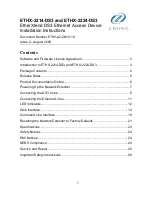
TD-W8910G
54M Wireless ADSL2+ Router User Guide
77
DSL
(
D
igital
S
ubscriber
L
ine)
-
An always-on broadband connection over traditional phone lines.
Dynamic IP Address -
A temporary IP address assigned by a DHCP server.
EAP (E
xtensible
A
uthentication
P
rotocol
) -
A general authentication protocol used to control
network access. Many specific authentication methods work within this framework.
Encryption -
Encoding data transmitted in a network.
Ethernet -
IEEE standard network protocol that specifies how data is placed on and retrieved
from a common transmission medium.
Firewall -
A set of related programs located at a network gateway server that protects the
resources of a network from users from other networks.
Gateway -
A device that interconnects networks with different, incompatible communications
protocols.
IEEE 802.11b -
The IEEE 802.11b standard specifies a wireless networking at 11 Mbps using
direct-sequence spread-spectrum (DSSS) technology and operating in the unlicensed radio
spectrum at 2.4GHz, and WEP encryption for security. IEEE 802.11b networks are also referred
to as Wi-Fi networks.
IEEE 802.11g -
Specification for wireless networking at 54 Mbps using direct-sequence
spread-spectrum (DSSS) technology, using OFDM modulation and operating in the unlicensed
radio spectrum at 2.4GHz, and backward compatibility with IEEE 8021b devices, and WEP
encryption for security.
Infrastructure Network -
An infrastructure network is a group of computers or other devices,
each with a wireless adapter, connected as an IEEE 802.11 wireless LAN. In infrastructure mode,
the wireless devices communicate with each other and to a wired network by first going through
an access point. An infrastructure wireless network connected to a wired network is referred to as
a Basic Service Set (BSS). A set of two or more BSS in a single network is referred to as an
Extended Service Set (ESS). Infrastructure mode is useful at a corporation scale, or when it is
necessary to connect the wired and wireless networks.
IP Address
- The address used to identify a computer or device on a network.
IPoA (IP
and
ARP
over
ATM)
-
A protocol that provides extensions to the IP Group for handling IP
over ATM flows.
ISP
(
I
nternet
S
ervice
P
rovider)
-
A company that provides access to the Internet.
LAN
- The computers and networking products that make up your local network.
MAC
(
M
edia
A
ccess
C
ontrol)
Address -
The unique address that a manufacturer assigns to each
networking device.
NAT
(
N
etwork
A
ddress
T
ranslation)
-
NAT technology translates IP addresses of a local area
network to a different IP address for the Internet.
MER (MAC E
ncapsulation
R
outing
) - MER
allows IP packet to be carried as bridged frames.
There are many applications, such as IPoA, DSL networks and other frame-based network.
Depending on your equipment, they can be either bridged or routed within the network.




































